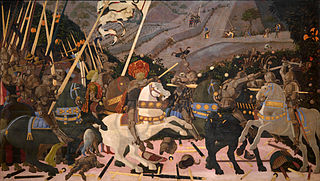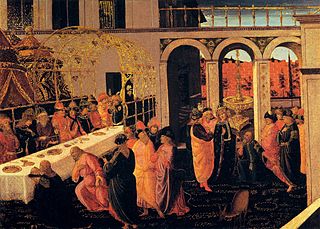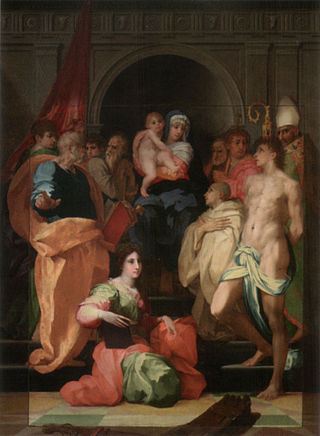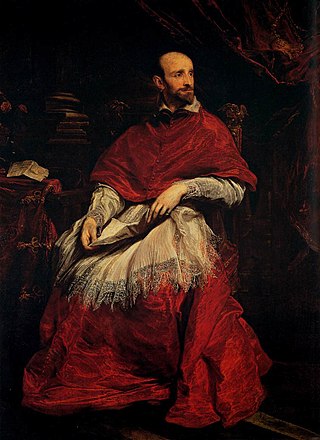
The Battle of San Romano is a set of three paintings by the Florentine painter Paolo Uccello depicting events that took place at the Battle of San Romano between Florentine and Sienese forces in 1432. They are significant as revealing the development of linear perspective in early Italian Renaissance painting, and are unusual as a major secular commission. The paintings are in egg tempera on wooden panels, each over 3 metres long. According to the National Gallery, the panels were commissioned by a member of the Bartolini Salimbeni family in Florence sometime between 1435 and 1460. The paintings were much admired in the 15th century; Lorenzo de' Medici so coveted them that he purchased one and had the remaining two forcibly removed to the Palazzo Medici. They are now divided between three collections, the National Gallery, London, the Galleria degli Uffizi, Florence, and the Musée du Louvre, Paris.

Jacopo Zucchi was a Florentine painter of the Mannerist style, active in Florence and Rome.

The Novitiate Altarpiece or Madonna and Child with Saints is a c.1440-1445 tempera on panel painting by Filippo Lippi, now in the Uffizi in Florence. A sacra conversazione, it originally had a predella painted by Pesellino centred on a Nativity. The main panel shows Cosmas and Damian either side of the Madonna and Child, whilst Francis of Assisi is shown at far left and Anthony of Padua at far right. On an architectural frieze above the figures are the Medici's heraldic balls.

The Panciatichi Holy Family or Panciatichi Madonna and Child is a 1541 oil on panel painting by Bronzino, signed on a stone in the bottom left corner. It is now in the Uffizi in Florence, where it was first recorded in the Tribuna in 1704, where it remained until 2010, when it was moved as part of the "New Uffizi" project. Preparatory drawings for the work are in the Uffizi's Gabinetto dei Disegni e delle Stampe and in the Phillips collection in London.

The Forge of Vulcan or Vulcan's Forge is an oil-on-copper painting by the Italian artist Giorgio Vasari, executed c. 1564, now in the Uffizi in Florence. A copy painted c. 1565–1567 by Pier Candido is now in Windsor Castle as part of the Royal Collection.

The Esther and Ahasuerus Coffer is a group of five c.1490 tempera on panel paintings of scenes by Jacopo del Sellaio, whose studio specialised in the production of such coffers and cassoni. Influenced by Bartolomeo di Giovanni, another painter of cassoni and coffers, three panels are now in the Uffizi in Florence. Two other panels are in the collection of the Louvre and the Museum of Fine Arts, Budapest.

Nativity of Saint John the Baptist is a 1526 oil on panel desco da parto painting by Pontormo, now in the Uffizi, where it has been since at least 1704. There is a copy in the Fogg Art Museum. Its status as an autograph work is accepted by most art critics, but was disputed by Philippe Costamagna.

The Doria Madonna is a c.1525 oil on panel painting by Parmigianino, now in the Galleria Doria-Pamphili in Rome. Its shape and dimensions show it to form a diptych with the Nativity with Angels in the same gallery. A smaller autograph version also survives in the Uffizi.

The Dei Altarpiece is an oil on panel painting by Rosso Fiorentino, commissioned in 1509 by the Dei family and completed in 1522. It is now in Florence's Galleria Palatina, whilst the Uffizi holds a preparatory drawing which may be the original idea for the work.

Woman with a Basket of Spindles is an oil-on-panel painting, executed c. 1514–1515, now in the Uffizi in Florence. It is attributed to Pontormo or Andrea del Sarto. The work arrived in the Palazzo Pitti's gallery in 1773, as recorded in a note on the reverse, and in 1784 it was hanging in the Sala dell'Ermafrodito. It was last restored in 1996.

Madonna of the Book is a c.1540–1545 oil on panel painting by Pontormo, heavily influenced by Michelangelo and now in a private collection. It may be the work described in Lives of the Artists as a "canvas of Our Lady" found among drawings, cartoons and terracotta models in the painter's home after his death and which was then given to Piero Salviati by the painter's heirs.

Saint Anthony Abbot is an oil on panel painting by Pontormo, now in the Uffizi in Florence.

Portrait of Cosimo the Elder is an oil on panel painting by Pontormo, executed c. 1519–1520, now in the Uffizi, Florence.

Portrait of Cardinal Guido Bentivoglio is an oil on canvas painting of Guido Bentivoglio by Anthony van Dyck, now in the Galleria Palatina in Florence. It was painted around 1623 during the artist's stay in Italy - Bentivoglio had links to the artist's native Flanders.

Self-Portrait on an Easel is a 1603-1604 oil on panel painting by Annibale Carracci, now displayed in Room 231 of the New Hermitage Building of the Hermitage Museum in Saint Petersburg. The portrait from the work was repeated for an autograph self-portrait now in the Uffizi, whilst a 1595 version of the Hermitage work is also in the Uffizi.

The Golden Age is a c. 1576–1581 oil on panel painting of the Golden Age by Jacopo Zucchi, a favoured artist of Ferdinando I de' Medici at the end of the latter's cardinalate in Rome, now in the Uffizi, in Florence.

The Martyrdom of Saint Florian is an oil-on-panel painting executed c.1518–1520 by the German artist Albrecht Altdorfer, signed with his "A in A" monogram on a post of the bridge on the right. It and the artist's Saint Florian Taking Leave of the Monastery were in the Spannocchi collection of the Pinacoteca nazionale di Siena until 1914, when they were both transferred to their present home in the Uffizi in Florence to strengthen the latter's holdings on the Northern Renaissance.

The Resurrected Christ is a 1511–1512 oil on panel painting by Titian, now in the Uffizi in Florence with catalogue number 10093. It was acquired by that collection on 18 October 2001 and restored in 2001–2002.

Madonna and Child is an oil on panel painting by Cima da Conegliano, created c. 1504, that now hangs in the Uffizi in Florence. It has an early copy attributed to Antonio Maria da Carpi, now in the Musei civici di Padova.

Madonna and Child is an oil-on-panel painting created in 1504 by the Italian Renaissance painter Cima da Conegliano, now in the Museo nazionale atestino in Este. It is the most important pictorial work in the museum, which is mainly dedicated to archeology.




















